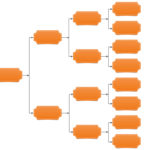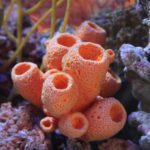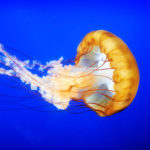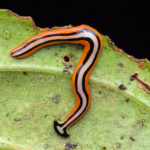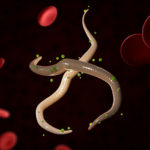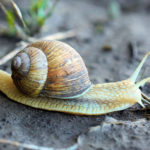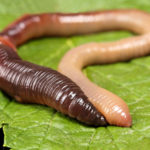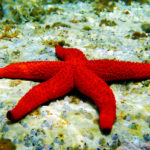1Animal Kingdom Classification
Classification is the grouping of things that are similar. At first, animal kingdom classification was based on physical features. For example, one can divide animals into groups with legs or no legs. Later, animal kingdom classification became more complex. It started to include how embryos developed. Lastly, the family tree is also built on genetic information. In other words, the family tree is also based on RNA and DNA. DNA is a molecule that contains genetic information in our cells.
[Click on thumbnail images for a full sized image].
2Porifera: Simple Animals Without Tissues
The study of animal kingdom classification begins with sponges. Sponges belong to the phylum Porifera. Over 5,000 species exist. They are mostly marine animals.
Traits: Sponges are animals with no body tissues or organs. They lack symmetry. Sponges are multicellular. They have specialized cells that recognize on another. Lastly, food is digested within cells. In other words, food is not digested in a separate digestive organ like a stomach.
Recommended Readings
3Cnidaria: Simple Animals With Tissues
Next in animal kingdom classification is Cnidaria. Phylum Cnidaria includes corals, hydras, jellyfish and sea anemones. There are about 10,000 living species. The vast majority are marine animals.
Traits: Cnidarians are multicellular. They have radial symmetry. They also have specialized tissues. For example, some tissues make up stinging cells. Gut tissues enable digestion of food in a gut cavity. Therefore, digestion takes place outside of the animal cells.
Recommended Readings
4Platyhelminthes: Flatworms Without Body Cavities
Platyhelminthes includes flukes, planaria and tapeworms Over 20,000 species exist. They can be freshwater or marine. Some are parasitic and live within other organisms.
Traits: Platyhelminthes are multicellular. Second, they have bilateral symmetry. In other words, they have a left and right half. Next, these worms have tissues that are organs. Organs are a group of tissues that function as a unit. For example, the heart is an organ that circulates blood. However, platyhelminths lack body cavities. Organs are located in the body cavity. Nevertheless, platyhelminths have a digestive tract. The digestive tract has one mouth opening. As a result, the mouth consumes food. Later, the mouth must excrete waste.
5Nematoda: Roundworms With Body Cavities
Roundworms are nematodes. There are over 20,000 species. They live in many different environments. They exist in marine and freshwater. Nematodes also live in soil. Lastly, some live within other animals as parasites.
Traits: Nematodes are multicelled. They possess bilateral symmetry. In addition, they have organs. Their digestive track has two openings. These are the mouth and anus. The mouth consumes food. After digestion, waste is excreted at the anus. Nematodes possess a body cavity. The cavity is located between the gut and body wall. Nutrients pass from the gut to the body.
6Mollusca: Unsegmented Animals With a Coelom
The Mollusca phylum includes snails, clams, and octopuses. There are over 110,000 mollusk species. They are mostly marine creatures. However, some exist on land. Snails and slugs are the gastropods subgroup. Clams, oysters, and scallops are bivalves. Finally, the octupus and squid are cephlopods.
Traits: Mollusks have bilateral symmetry. They are unsegmented. In other words, they do not have body parts that are duplicated again and again. Instead, they have a body cavity known as the coelom. The coelom is located between the body wall and digestive tract. The coelom contains the soft internal organs. For example, the coelom contains the stomach and intestines.
7Annelida: Segmented Animals With a Coelom
Annelida is a phylum of worms. There are over 12,000 species. Earthworms belong to this phylum. Annelids live in the sea, freshwater, and in the soil.
Traits: Annelids have bilateral symmetry. They have segmentation. Segmention means that the body is like a chain. Similar segments are linked together. Segmentation is easy to see in the earthworm photo. Each segment has a coelom. The coelom has organs such as hearts, brain, and blood vessels. A digestive tract also runs from the mouth to the anus.
8Arthropoda: Jointed Legs and Exoskeleton
Arthropoda is the largest phylum. This phylum has more than 1,000,000 species. Insects are the largest group. Crustaceans, spiders, and centipedes are smaller Arthropod groups. They are located in all environments.
Traits: Arthropods are multicellular with bilateral symmetry. They have a coelom. Arthropods are also segmented. However, these segments fuse together as adults. For example, the larva of flies resemble a small worm with many segments. However, the adult fly has three body segments. Arthropods have jointed limbs. Jointed limbs make walking possible. However, jointed limbs also have other functions. Antennae for example, are used for sensing. Lastly, arthropods have a rigid exoskeleton. An exoskeleton is an external skeleton. It is made of chitin.
9Echinodermata: Deuterostomes with an Endoskeleton
The echinoderm phylum includes starfish, sea urchins, and sea cucumbers. About 6,000 species exist today. They are mostly marine animals.
Traits: First, echinoderms have bilateral symmetry as larva. However, as adults they develop radial symmetry. Radial symmetry is the arrangement of similar features around a center. Any cut through the center results in two similar halves. Second, echinoderms possess an endoskeleton. The endoskeleton is made up of hard plates just underneath the skin. Finally, most echinoderms are able to regrow lost limbs.
10Chordata: Deuterostomes with a Notochord
The final phylum in animal kingdom classification is the Chordata. Chordates are animals with a notochord. Amphibians, birds, fish, mammals, and reptiles have a backbones and head. Tunicates and lancelets are chordates that do not. There are over 55,000 species. They are found in all habitats.
Traits: Chordates have a notochord. It is a flexible rod that develops on the embryo. Second, they have a nerve cord. Third, they have pharyngeal pouches. These pouches are located at the back of the mouth. Lastly, chordates have a postnatal tail. Vertebrate chordates have a backbone and head.
Bibliography
- A Animal Study Guide
- About Animals
- Classification of Living Things, Palomar

